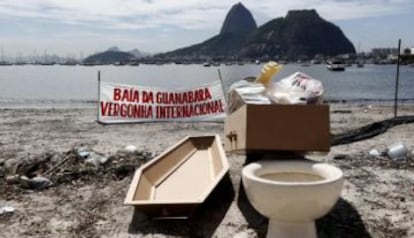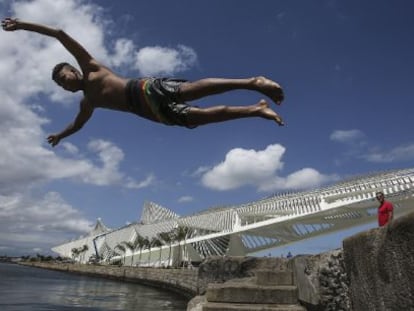The mystery of the body parts washing up in Rio de Janeiro
Disembodied extremities regularly pop up in the city that is about to host Summer Games

More bad news ahead of this year’s Olympics: a disembodied arm washed up on the shore a couple of weeks ago in Guanabara Bay, the future location of the sailing competitions at the 2016 Summer Olympics, to be hosted by Rio de Janeiro.
The bloodied extremity was floating in a thick foam the color of a cappuccino coffee. What’s more, a severed head appeared to be poking out of the water near the limb.
Yet most people in this bustling city didn’t bat an eyelash at the grisly news. The man who made the discovery took pictures, sent them to a newspaper, and stated: “I’ve seen other bodies floating around at other times. One last year, and another five years ago.”
Nature routinely reminds authorities about their unfulfilled promise of cleaning up the bay before the Games begin in August
The police said they would investigate, but the case ended there.
Indeed, this is not the first time that Rio has been confronted with such gruesome findings. In 2013, street sweepers found two sand-covered arms on the arch-famous beach of Ipanema. For nearly two years, one local journalist insisted on finding out who the extremities belonged to and how they got there. But the only thing he got from the police in return for his perseverance was a nickname for himself: “the arms reporter.”
The appearance of this new unidentified limb is just the latest in a series of problems afflicting Guanabara Bay, the final destination for the local sewer system and for the waste produced by millions of people.
Nature routinely reminds authorities about their unfulfilled promise of cleaning up the bay before the Games begin in August: the same week that the arm emerged from the waters, heavy rains washed in an enormous tide of trash, including egg cartons and plastic bottles, and deposited them at the door of the brand-new Museum of Tomorrow, designed by star Spanish architect Santiago Calatrava – who has just inaugurated the controversial World Trade Center Transportation Hub in New York City.
The picture of the new Olympic city was complete: a terribly expensive new museum, a recently revamped square with sea views, majestic ocean liners filled with tourists docked at the port – and a spectacular floating rubbish dump surrounding the scene.
English version by Susana Urra.
Tu suscripción se está usando en otro dispositivo
¿Quieres añadir otro usuario a tu suscripción?
Si continúas leyendo en este dispositivo, no se podrá leer en el otro.
FlechaTu suscripción se está usando en otro dispositivo y solo puedes acceder a EL PAÍS desde un dispositivo a la vez.
Si quieres compartir tu cuenta, cambia tu suscripción a la modalidad Premium, así podrás añadir otro usuario. Cada uno accederá con su propia cuenta de email, lo que os permitirá personalizar vuestra experiencia en EL PAÍS.
¿Tienes una suscripción de empresa? Accede aquí para contratar más cuentas.
En el caso de no saber quién está usando tu cuenta, te recomendamos cambiar tu contraseña aquí.
Si decides continuar compartiendo tu cuenta, este mensaje se mostrará en tu dispositivo y en el de la otra persona que está usando tu cuenta de forma indefinida, afectando a tu experiencia de lectura. Puedes consultar aquí los términos y condiciones de la suscripción digital.











































